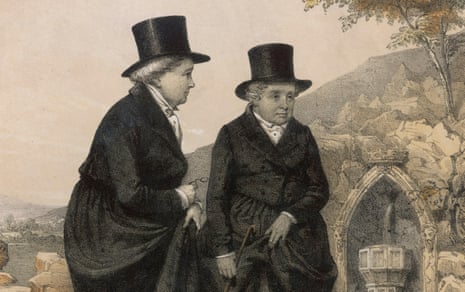On the night of 30 March 1778, in County Kilkenny, Ireland, a beautiful aristocratic orphan, Sarah Ponsonby, 23, put on men’s clothing, picked up a pistol and her little dog, Frisk, and climbed out of the window. She was living in the house of a relative, Sir William Fownes, and had repelled his unwelcome advances. That night, she met up with the woman she knew as her “beloved”, Lady Eleanor Butler, 39 (also dressed in men’s clothes), with a plan to catch the boat to England. They were caught by Sir William’s men, but two months later they persuaded their reluctant families to let them leave with Sarah’s faithful maidservant, Mary Carryl, to start a new life together in the wilds of north Wales, building a domestic idyll in a farmhouse they renamed Plas Newydd: new hall.
It sounds like the opening of a historical romance, but it is true, and it marks the start of something more profound than a sapphic bodice-ripper: this is the origin story of the Ladies of Llangollen. The irresistible tale of their passionate, 50-year “romantic friendship” and the elaborate, beautiful home and garden they constructed made them famous in their own lifetimes, and they have remained a symbol of enduring same-sex happiness ever since. They are “queer foremothers”, as a newly rereleased book about the Ladies, Chase of the Wild Goose, puts it.
Written by the feminist and prison-reform campaigner Dr Mary Gordon, and originally published in 1936 by Virginia and Leonard Woolf’s Hogarth Press, Chase is a real oddity. Part breathless romance – all swishing silk and impassioned declarations – and part accurate account of Eleanor and Sarah’s shared life, it ends with an exceptionally strange section, a sort of seance, with the author “meeting” the Ladies. She tells them about contemporary feminism and their supposed part in it: “You meditated among your books and dreamed us into existence.” Sarah Waters has called it “a fascinating piece of queer literary history”.
D-M Withers of Lurid Editions, which is republishing the book to coincide with the start of LGBT+ history month on 1 February, was inspired to get it back into circulation after a visit to Newydd: “I was surprised the book was out of print. It felt like a cultural injustice.” Chase, they say, “deserves to be read alongside other classic queer texts of the early 20th century, such as Orlando and The Well of Loneliness. Politically, it also felt vital to do my part – as Gordon did hers – in rejuvenating one of the greatest queer love stories of all time.”
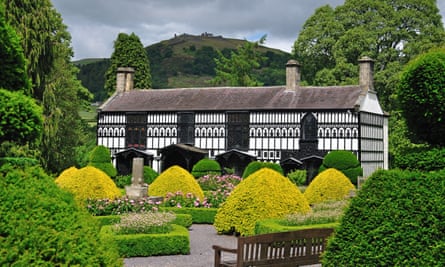
But what is that story and why did the Ladies make “a noise in the world which has never died out”, as Gordon put it? To understand better, I make the pilgrimage to Llangollen, a picturesque small town in rural north Wales. I walk up out of the town, along the former coach road to Holyhead and the Irish Sea, where the Ladies’ farmhouse sits, black and white and striking on the hilltop. The house is closed to the public until April but the garden is popular with local dog walkers and families: you can take the “Circuit”, as the Ladies called their daily constitutional, down to the stream and up to their tiny summer house where they would often sit and read. In a few weeks, the primroses will start to emerge.
“It’s a bit of a utopia, a bit of heaven,” says Chris Elsworth, who works at the house and shows me round, opening the intricately carved door with an oversized metal key. The house is extraordinary outside and in. The walls are panelled with gothic wooden carvings – pew ends, chair backs, pieces of chests and beds – collected piecemeal by the Ladies, or brought by their admirers (they made it known that a carved offering was a good way to gain an audience: the lions flanking the front door were apparently a gift from the Duke of Wellington). Plas Newydd was their life’s work and they shaped it over the years into the perfect rendering of Romantic rural living: 40 varieties of rose, fruit and vegetables, herbs, a well-stocked library – 18th-century cottagecore.
On a winter afternoon, Plas Newydd is chilly, still and intimate (“So still. So silent,” as Eleanor’s diary puts it), weak sun filtering through the jumble of stained glass collaged by the Ladies. I take in their china, Eleanor’s tiny buckled shoes, a bag Sarah embroidered and their initials carved on a beam. There’s a picture of Mary Carryl, the vital third element in the household, and another of the Ladies’ cat, Tatters.
It’s odd that such a quiet, domestic space generated such fascination in their lifetimes. Well-heeled and famous visitors included Sir Walter Scott, Josiah Wedgwood and William Wordsworth, who dedicated a sonnet to them (“Sisters in love, a love allowed to climb / Ev’n on this earth, above the reach of time”). “They would have several visitors a day,” Elsworth says.
Certainly, the Ladies’ “extraordinary female friendship” was the focus of curiosity fuelled by press coverage, much of it salacious and unwelcome. They considered suing one paper that called Eleanor “masculine” and Sarah “effeminate”, and made much of their “strange antipathy to the male sex”. Their instantly recognisable way of dressing – top hats and sober black riding habits – and old-fashioned powdered hair were reproduced on commemorative crockery, attracting gentle and not-so-gentle mockery: they were called “hermitesses” and likened to “two respectable superannuated old clergymen” or “a couple of hazy or crazy old sailors”.
However, the Ladies also attracted sincere admiration – though their domestic bliss meant different things to different people. On a conventional Romantic-era reading, they fit within the “established and well-worn trope of female romantic friendship”, according to Dr Nicole Reynolds of Ohio University, who has written about how their wholesome, decorative cottage life and the idyllic retreat it symbolised fitted with contemporary fashion and conferred respectability. That respectability was, it’s important to note, only available to them because of their aristocratic status. Although they had serious money worries in the early years, they were, in the main, treated with deference and respect.
Then there’s the vital role that Carryl played in facilitating their domestic bliss. “Also known as Molly the Bruiser,” according to Elsworth, she managed the household, negotiating with tradesmen and acting as gatekeeper to unwelcome visitors. On her death, the money she left to the Ladies (visitors would pay her for garden tours) enabled them to buy Plas Newydd, guaranteeing continued stability.
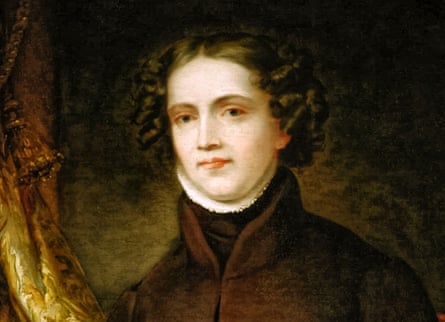
Eleanor’s extensive diaries of their life together – a gentle litany of reading, walking, gardening – are suffused with love and quiet contentment: “A day of peace and delight”; “A day of delicious retirement”, “Reading – writing and sharing a delicious day.” But they are also full of passionate endearments. “Beloved” is used so often it’s sometimes abbreviated to B, interspersed with “my sweet love” or “the darling of my heart”. Other contemporaries saw them, for good or ill, as symbols of same-sex desire. The diarist Hester Thrale called them “damned sapphists” in her journal, Reynolds says, and Byron mentioned them in a letter describing his attraction to a Cambridge choirboy. Meanwhile, Anne Lister, who has been popularised by the recent BBC television series Gentleman Jack, was so keen to meet the Ladies in 1822 that she spent two hours preparing. She saw them as a beacon of hope, admiring “their place and the happiness they had there”.
There is something very powerful about Plas Newydd. “The Ladies left an extraordinary presence,” Withers tells me, and I agree: it’s still inhabited by them. The artist Sarah-Joy Ford spent some time there last year, creating quilted and textile works inspired by Sarah Ponsonby’s craft work, by the house and by the Ladies’ relationship. “I could spend my days alone in the house with the ghosts of the Ladies,” she says. “I was very much channelling Mary Gordon, waiting for them to come and have a chat.” The Ladies have been part of Ford’s life as long as she can remember: “I’ve always been so invested in lesbian and LGBT+ history, and they’re these iconic figures.” She and her partner are planning to get married there. “Often you’ll get gay couples coming and they will see it as a mecca,” says Elsworth. Withers adds: “As a queer person, it is very rare to visit locations where queer people had actually lived, and not only lived but created a life.”
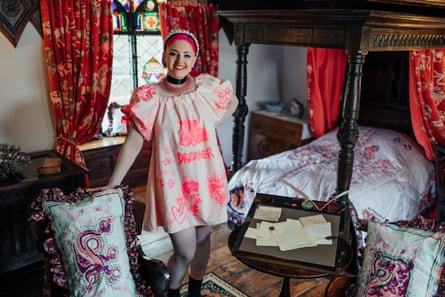
After 50 years of that life, the couple were buried together, along with Carryl, the grave marked by a three-sided monument in St Collen’s churchyard, at the bottom of the hill. Eleanor died in 1829, aged 90, while Sarah “did not survive long her beloved companion” as the monument says; she died in 1831. They could have become a historical footnote, a curiosity, but something in their story remains irresistible, as Chase of the Wild Goose shows.
“At this point in the 1930s, the Ladies were definitely having a moment,” according to the author Frances Bingham, who has written about queer life and literature of the period. She describes Chase of the Wild Goose as “magnificently weird” – old-fashioned, but with interesting nods to modernism and 20s and 30s “spiritualist sapphism”. “They’d been so famous in their lifetime for their romantic friendship. Then, in a more knowing era, I think they were read completely differently.” They became, she says, “a sort of shorthand for same-sex love in a cottage again”. The writer Sylvia Townsend Warner suggested to the poet Valentine Ackland that they could be like the Ladies: a sort of coded come-on, according to Bingham, who has written a biography of Ackland. In 1932, the French writer Colette included them in The Pure and the Impure, her collection of reflections on sex, gender and desire.
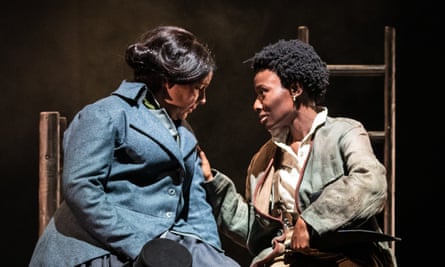
They are still a creative inspiration today. In addition to Ford’s installation, last year Katie Elin-Salt and Eleri Jones staged Celebrated Virgins, a play inspired by the Ladies and Mary Carryl. Elin-Salt came later to their story, and when Jones told her about it, “I was absolutely transfixed,” she says. “I was amazed that, as a queer woman living in Wales, there was this huge part of our history that I didn’t even know about.” The play relishes the drama of the narrative, but, says Elin-Salt, tries to get to “the heart of the love they had for each other”. It also examines the paradox of their visibility and simultaneous isolation: “It’s a constant battle that a lot of queer people and lesbian women have: how seen do we want to be?” At the end of the play, the Ladies return to Plas Newydd “holding hands and celebrating their love”.
What actually was Eleanor and Sarah’s relationship? Was it physical or a precursor of queerplatonic? They slept in the same bed, but reacted to any suggestion they were physically intimate with asperity. Does it matter? “The question always comes up,” says Elin-Salt. Living with a group of queer and lesbian women during lockdown as she researched the Ladies, they talked through the issue at length, concluding that if the pair had been a man and a woman, the question would never have arisen. In Celebrated Virgins, “We decided we were just going to stick to the truth and what we knew: that these were two women who absolutely loved each other, risked everything to be with each other and lived in harmony together for over 50 years.”
Their relationship certainly piqued the curiosity of Lister, who speculated about it with her lover Mariana, concluding: “I cannot help thinking that surely it was not platonic.” “One has to be very intellectually austere and careful and say, ‘Of course we’ll never know’, and all of that stuff,” says Bingham. “But actually, I’m on Anne Lister’s side with this one. I hope so, anyway. I’d much rather think they had a happy and fulfilled sexual life than that they just sat and held hands.”
The words that come back again and again when talking about the Ladies are “hope” and “joy”. For Withers, they are “a beacon of hope – a celebration of the endurance of queer love”. I ask Sarah-Joy Ford to expand on something she said about Chase of the Wild Goose offering the possibility of “being haunted by queer joy”, which seems a perfect evocation of what the Ladies represent. “There is so much pain,” she says, in queer history. “But to find those pockets of joy, that’s so important. They’ve been this roadmap for women to build different lives together.”
Chase of the Wild Goose is published by Lurid Editions on 1 February (£9.99). To support the Guardian and Observer, order your copy at guardianbookshop.com. Delivery charges may apply
Do you have an opinion on the issues raised in this article? If you would like to submit a response of up to 300 words by email to be considered for publication in our letters section, please click here.
